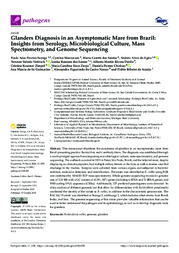Glanders Diagnosis in an Asymptomatic Mare from Brazil: Insights from Serology, Microbiological Culture, Mass Spectrometry, and Genome Sequencing.
Glanders Diagnosis in an Asymptomatic Mare from Brazil: Insights from Serology, Microbiological Culture, Mass Spectrometry, and Genome Sequencing.
Author(s): SUNIGA, P. A. P.; MANTOVANI, C.; SANTOS, M. G. dos; EGITO, A. A. do; VERBISCK, N. V.; SANTOS, L. R. dos; DÁVILA, A. M. R.; ZIMPEL, C. K.; ZERPA, M. C. S.; CHIEBAO, D. P.; GUIMARÃES, A. M. DE S.; NASSAR, A. F. DE C.; ARAUJO, F. R.
Summary: ABSTRACT - This manuscript elucidates the occurrence of glanders in an asymptomatic mare from Brazil presenting positive Burkholderia mallei antibody titers. The diagnosis was established through a multi-pronged approach encompassing microbiological culture, mass spectrometry, and genome sequencing. The outbreak occurred in 2019 in Tatuí, São Paulo, Brazil, and the infected mare, despite displaying no clinical symptoms, had multiple miliary lesions in the liver, as well as intense catarrhal discharge in the trachea. Samples were collected from various organs and subjected to bacterial isolation, molecular detection, and identification. The strain was identified as B. mallei using PCR and confirmed by MALDI-TOF mass spectrometry. Whole-genome sequencing revealed a genome size of 5.51 Mb with a GC content of 65.8%, 5871 genes (including 4 rRNA and 53 tRNA genes), and 5583 coding DNA sequences (CDSs). Additionally, 227 predicted pseudogenes were detected. In silico analysis of different genomic loci that allow for differentiation with Burkholderia pseudomallei confirmed the identity of the isolate as B. mallei, in addition to the characteristic genome size. The BAC 86/19 strain was identified as lineage 3, sublineage 2, which includes other strains from Brazil, India, and Iran. The genome sequencing of this strain provides valuable information that can be used to better understand the pathogen and its epidemiology, as well as to develop diagnostic tools for glanders.
Publication year: 2023
Types of publication: Journal article
Unit: Embrapa Beef Cattle
Observation
Some of Embrapa's publications are published as ePub files. To read them, use or download one of the following free software options to your computer or mobile device. Android: Google Play Books; IOS: iBooks; Windows and Linux: Calibre.
Access other publications
Access the Agricultural Research Database (BDPA) to consult Embrapa's full library collection and records.
Visit Embrapa Bookstore to purchase books and other publications sold by Embrapa.

